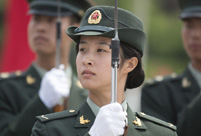 Chinese Kung Fu charms Silicon Valley
Chinese Kung Fu charms Silicon Valley
 Tranquil Yankou ancient town
Tranquil Yankou ancient town
 Lake Geneva: A show of swans
Lake Geneva: A show of swans
 Beautiful sunset over the Irtysh River
Beautiful sunset over the Irtysh River
 Qingjing Mosque: Witness of the ancient Maritime Silk Road
Qingjing Mosque: Witness of the ancient Maritime Silk Road
 Neiliansheng – more than 100 years of fashion
Neiliansheng – more than 100 years of fashion
 Golden retriever feeds baby African lions
Golden retriever feeds baby African lions
 Strange rocks in Lama Mountain
Strange rocks in Lama Mountain
 First overseas "China-standard" electric railway laid
First overseas "China-standard" electric railway laid
 College graduate launches organic agricultural cooperative in hometown
College graduate launches organic agricultural cooperative in hometownBEIJING, June 3 -- The Chinese cabinet's decision to carry out targeted reserve requirement ratio (RRR) cuts in more banks is in line with its pledge to deepen financial reform and better serve the real economy, which analysts say will ultimately boost economic restructuring.
The State Council, China's cabinet, announced last week that the country will lower the RRR for banks engaged in proportionate lending to the agriculture sector and small and micro-sized enterprises (SMEs). Details of when and how much the cuts will be have not yet been announced.
The targeted credit policy continues after the RRR was cut for county-level rural commercial banks by 2 percentage points and for rural credit cooperative unions by 0.5 percentage point in April.
"Targeted RRR cuts are award measures that aim to boost financial support for the real economy. Compared to systemic RRR cuts, the distinguishing policy is more targeted and will guide credit to agriculture and small firms that badly need it," said Ji Zhihong, director of the financial market department under the central bank.
Ji forecast that the targeted cuts in RRR this time may prioritize banks that grant proportionate loans to SMEs, because RRR cuts have previously covered rural-based banks and financial institutions.
The RRR sets the minimum fraction of customer deposits that each bank must hold as reserves rather than lending, and is an important monetary tool used by central banks. Lowering the RRR is often aimed at boosting bank lending to shore up economic growth.
Analysts said the targeted move indicated that broad-based RRR reductions for banks are unlikely in the near future.
In the same statement, the cabinet said that it will optimize the country's financing structure, with financial resources to be allocated to support vital state projects, companies' upgrading efforts, and service sectors.
Guo Tianyong, a researcher at the Beijing-based Central University of Finance and Economics, said the cabinet's call to optimize the financing structure is a key point in the country's push for economic restructuring.
Railway and water-related projects, energy, shanty-town renovations, affordable home construction and municipal infrastructure projects will have more credit support. The upgrading of companies, emerging industries of strategic importance, high-tech sectors and daily services sectors will also enjoy favorable credit policies, Ji said.
At the same time, the central bank's monetary policies will squeeze credit lending out of low-efficiency industries, with local government financing vehicles, industries with excessive production capacity and the real estate sector likely to have their borrowing strictly controlled, Ji said.
Zhang Xiaopu, a policy research official at the China Banking Regulatory Commission (CBRC), said that the CBRC will further reforms in the banking sector with an eye to enhance risk control and bank services. Zhang's remarks come as the country faces the rapid rise of shadow banking, which has brewed financial risks and raised companies' financing costs in recent years.
Some changes are in sight. Data from the People's Bank of China, the central bank, said that banks' medium and long-term loans to service sectors rose 15.5 percent year on year as of the end of April, with the growth rate picking up by 1.8 percentage points. In contrast, medium and long-term credit to industries with excessive production capacity grew only 5.9 percent, down 1.6 percentage points.

 Opening ceremony of 67th Cannes Film Festival
Opening ceremony of 67th Cannes Film Festival Pulse of Xiamen - Int'l Yoga art festival in May
Pulse of Xiamen - Int'l Yoga art festival in May Photo story: Life of a scrap metal recycle worker
Photo story: Life of a scrap metal recycle worker Training of the PLA's first female honor guard
Training of the PLA's first female honor guard China's 10 must-see animations
China's 10 must-see animations Female bodybuilders show their beauty of fitness
Female bodybuilders show their beauty of fitness A taste of Harbin cuisine
A taste of Harbin cuisine A bite of Jiang Nan
A bite of Jiang Nan Who is China's campus beauty queen?
Who is China's campus beauty queen? 8 great movies to watch with your mom
8 great movies to watch with your mom China's most luminous celebrities
China's most luminous celebrities Newly recruited police in Hetian hold drill
Newly recruited police in Hetian hold drill  Bird-men compete flying in Hong Kong
Bird-men compete flying in Hong Kong  The 'Chinese Dad'
The 'Chinese Dad' Shanghai locals bid farewell to childhood memories
Shanghai locals bid farewell to childhood memoriesDay|Week|Month